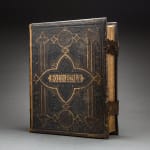Ornate Leather-Bound and Illustrated Brown's Family Bible Containing the Old and New Testaments, 1800 CE
Printed Book
33.7 x 27.9 cm
13 1/4 x 11 in
13 1/4 x 11 in
SF.004
Further images
The Secessionist Church originated in the dissatisfaction of four Church of Scotland ministers, most notably Alexander Moncrieff, with the Scottish Presbyterian Church’s ‘sufferance of error without adequate censure; the infringement...
The Secessionist Church originated in the dissatisfaction of four Church of Scotland ministers, most notably Alexander Moncrieff, with the Scottish Presbyterian Church’s ‘sufferance of error without adequate censure; the infringement of the rights of the Christian people in the choice and settlement of ministers under the law of patronage; the neglect or relaxation of discipline; the restraint of ministerial freedom in opposing mal-administration, and the refusal of the prevailing party to be reclaimed.’ As a result, they split from the Church’s judicatures to form their own. This remarkable revolution inspired, among others, one young man: John Brown.
John Brown was born in AD 1722 in the Scottish town of Carpow, Perthshire. A precocious and intelligent child, he was almost entirely self-educated. It was while working as a shepherd that he first built his acquaintance with ancient languages, and by the age of twenty he had become conversant in Latin, Greek and Hebrew. His itinerant lifestyle saw him take positions as a merchant, a soldier, and a school-master, but it was as a preacher that he found his calling. From AD 1750 until his death in AD 1787, he was the minister at the Secessionist Church in Haddington, East Lothian. From AD 1768 he was the professor of divinity for the sect, instructing its young ministers.
Perhaps Brown’s best-known achievement was the publishing, in AD 1778, of his Self-Interpreting Family Bible, originally printed in two volumes in Edinburgh. The purpose of the work was, in his own words from the preface, to present the best of Christian commentary ‘in a manner that might best comport with the ability and leisure of the poorer and labouring part of mankind, and especially to render the oracles of God their own interpreter.’ His work was immediately popular, and achieved a wide readership across the English-speaking nations. It seemed to strike a particular resonance in the newly-founded United States, as well as in the Highlands of Scotland and mid-Wales. Such was the fame of Brown’s work, that he was listed alongside John Bunyan and Thomas Boston by Robert Burns in his Letter to James Tail of Glenconner (ll.19-22).
John Brown was born in AD 1722 in the Scottish town of Carpow, Perthshire. A precocious and intelligent child, he was almost entirely self-educated. It was while working as a shepherd that he first built his acquaintance with ancient languages, and by the age of twenty he had become conversant in Latin, Greek and Hebrew. His itinerant lifestyle saw him take positions as a merchant, a soldier, and a school-master, but it was as a preacher that he found his calling. From AD 1750 until his death in AD 1787, he was the minister at the Secessionist Church in Haddington, East Lothian. From AD 1768 he was the professor of divinity for the sect, instructing its young ministers.
Perhaps Brown’s best-known achievement was the publishing, in AD 1778, of his Self-Interpreting Family Bible, originally printed in two volumes in Edinburgh. The purpose of the work was, in his own words from the preface, to present the best of Christian commentary ‘in a manner that might best comport with the ability and leisure of the poorer and labouring part of mankind, and especially to render the oracles of God their own interpreter.’ His work was immediately popular, and achieved a wide readership across the English-speaking nations. It seemed to strike a particular resonance in the newly-founded United States, as well as in the Highlands of Scotland and mid-Wales. Such was the fame of Brown’s work, that he was listed alongside John Bunyan and Thomas Boston by Robert Burns in his Letter to James Tail of Glenconner (ll.19-22).













